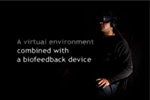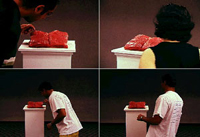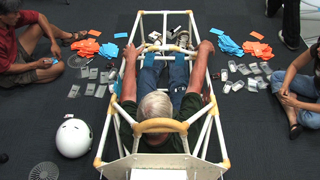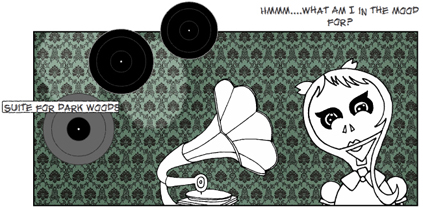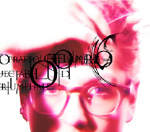Difference between revisions of "Projects"
Ccastellanos (talk | contribs) (→Walking Meditation) |
|||
| (32 intermediate revisions by 7 users not shown) | |||
| Line 1: | Line 1: | ||
| − | + | = Transforming Pain = | |
| + | |||
| + | == Walking Meditation == | ||
| + | |||
| + | [[3D sound resources]] | ||
| + | |||
| + | [[Resonant frequencies]] | ||
| + | |||
| + | [[Frequency sensitivities]] | ||
| + | |||
| + | [[Sound & Music samples]] | ||
| + | |||
| + | [[CFI equipment grant]] | ||
| + | |||
| + | [[Pain contact list]] | ||
| + | |||
| + | <br><br> | ||
| + | |||
| + | == Banyan Tree == | ||
| + | |||
| + | What are the consequences of surfing the web for the next news headline, a nice pair of new shoes, or pornography? Can we <br> | ||
| + | spoil the real environment by exploring virtual ones? This installation piece will both directly address these sorts of <br> | ||
| + | questions about the environmental and ecological consequences of internet consumption, and also explore this relationship <br> | ||
| + | through an immersive, yet non-traditional mix of virtual and physical reality of the tangled tree of pleasure-seeking and <br> | ||
| + | environmental-destruction that we have made for ourselves in the internet. This immersive exhibit will use a virtual <br> | ||
| + | representation of a Banyan tree to explore these issues. | ||
| + | |||
| + | The Banyan tree was chosen as metaphor because its unique structure and growth pattern simultaneously embody both the typical <br> | ||
| + | modernist idea of the tree and the more contemporary idea of the rhizome. That is, in a Banyan tree, it is hard to know <br> | ||
| + | which is the parent trunk, whether root is branch or vice versa, etc. Working as both tree and rhizome, the ancient Banyan <br> | ||
| + | is a metaphor for antediluvian and contemporary connectedness. Through exploration and habitation of a penetrable Banyan tree, <br> | ||
| + | interactors will experience the ecological and environmental costs of internet consumption; translucent roots reveal diverse <br> | ||
| + | energy sources that imply levels and types of consumption. In effect, the interactors are a consumed energy (source of pleasure)<br> | ||
| + | |||
| + | boundless tree. <br><br> | ||
| + | |||
| + | = Other Projects = | ||
| + | |||
| + | |||
| + | '''Meditation Chamber''' | ||
| + | |||
| + | [[Image:MeditationC.jpg]] | ||
| + | |||
| + | VR Environment that responds to a person's state by <i>Diane Gromala</i> | ||
| + | |||
| + | |||
| + | The Meditation Chamber is an immersive VR environment that provides users with real-time feedback. Wearing a head-mounted <br> | ||
| + | display and biofeedback device, users are guided through a series of relaxation and meditation techniques. In real-time, <br> | ||
| + | the audio and visuals are synced to the users' continually changing physiological states (respiration, pulse rate and sweat <br> | ||
| + | gland activity (a measure of calmness)). As users' approach meditative states, the hypnotic visuals dissolve to moving <br> | ||
| + | mist and darkness as the user relaxes. Exhibited at SIGGRAPH's Emerging Technologies, and seen on CNN. | ||
| + | |||
| + | |||
| + | ---- | ||
| + | |||
| + | |||
| + | '''MeatBook''' | ||
| + | |||
| + | [[Image:Metbook.jpg]] | ||
| + | |||
| + | A project that provokes users' senses of their visceral responses by <i>Diane Gromala</i> | ||
| + | |||
| + | |||
| + | A time-based (that is, decaying) slab of meat, constructed as a book, is embedded with various sensors that cause the meat <br> | ||
| + | to react and quiver as the viewer approaches it. The reanimated flesh also responds with other movements and sound when <br> | ||
| + | users touch it. The next stage of development includes artificial intelligence and explores notions of generative art. | ||
| + | |||
| + | |||
| + | ---- | ||
| + | |||
| + | |||
| + | '''Neurofloat''' | ||
| + | |||
| + | [[Image:neurofloat.jpg]] | ||
| + | |||
| + | A novel interface for exploring brain data by <i>Steven Barnes & Meehae Song</i> | ||
| + | |||
| + | |||
| + | The goal of the NeuroFloat project is to create an interactive system that uses electroencephalographic (EEG) or other <br> | ||
| + | biological signals obtained from the user as a primary input for navigation through an immersive real-time 3-D visualization <br> | ||
| + | of various regions of the human brain. One of our primary goals is to create a system where the brain-computer interface <br> | ||
| + | is intrinsically related to content of the virtual-reality (VR) environment that it interfaces with. Accordingly, we have <br> | ||
| + | chosen to develop multiple VR environments that collectively represent a tour through the early stages of the users very <br> | ||
| + | own visual system. | ||
| + | |||
| + | |||
| + | ---- | ||
| + | |||
| + | |||
| + | '''Unconventional Racecar Interfaces''' | ||
| + | |||
| + | [[Image:Abstractchassis.jpg]] | ||
| + | |||
| + | A tool for creating interfaces with racecar drivers by <i>Jack Sam</i> | ||
| + | |||
| + | |||
| + | A person's psychological and physiological states are different when driving a racecar from when commuting to work. The <br> | ||
| + | goal of this research method and its tools is to understand the experience of racing and to use this knowledge to design <br> | ||
| + | novel interfaces for racecars. | ||
| + | |||
| + | |||
| + | ---- | ||
| + | |||
| + | |||
| + | '''Scarlet Skellen and the Absent Urchins''' | ||
| + | |||
| + | [[Image:Scarletskellen.jpg]] | ||
| + | |||
| + | A novel interface that changes aesthetics based on affective states by <i>Angela Tomizu & Joshua Tanenbaum</i> | ||
| + | |||
| + | |||
| + | Scarlet Skellen and the Absent Urchins is an interactive, multimedia comic book that employs a user modeling approach <br> | ||
| + | for affective interaction. | ||
| + | |||
| + | |||
| + | ---- | ||
| + | |||
| + | |||
| + | '''BioMorphic Typography''' | ||
| + | |||
| + | |||
| + | [[Image:Biotype.jpg]] | ||
| + | |||
| + | |||
| + | BioMorphic Typography is Gromala's term for a family of fonts that respond, in real-time, to a user's changing physical <br> | ||
| + | states, as measured by a biofeedback device. Rather than one typeface, it is a postmodern pastiche of many different fonts <br> | ||
| + | that are continually morphing. So, for example, the font "throbs" as the user's/writer's heart beats, expands as the user <br> | ||
| + | breathes, and "spikes" according to galvanic skin response. In this way, users become aware of their autonomic states <br> | ||
| + | -- physiological states that usually remain under our conscious awareness. This project is part of a larger initiative, <br> | ||
| + | Design for the Senses. The goal is to develop new approaches to experiential design that focus on the senses and the <br> | ||
| + | phenomenological history of the body.<br><br> | ||
| + | |||
| + | |||
| + | |||
| + | ---- | ||
| + | |||
| + | =Links & References= | ||
| + | |||
| + | [http://bit.ly/daaSto Readings in Human-Computer Interaction: A Multidisciplinary Approach] | ||
| + | |||
| + | [http://bit.ly/ajuT9U Human Factors in Typography for More Readable Programs] | ||
| + | |||
| + | [http://bit.ly/aZ2Z9e Readings in Groupware and Computer-Supported Cooperative Work: Facilitating Human-Human Collaboration] | ||
| + | |||
| + | [http://bit.ly/9BvEWF Readings in Human-Computer Interaction: Towards the Year 2000] | ||
Latest revision as of 22:32, 11 August 2010
Contents
Transforming Pain
Walking Meditation
Banyan Tree
What are the consequences of surfing the web for the next news headline, a nice pair of new shoes, or pornography? Can we
spoil the real environment by exploring virtual ones? This installation piece will both directly address these sorts of
questions about the environmental and ecological consequences of internet consumption, and also explore this relationship
through an immersive, yet non-traditional mix of virtual and physical reality of the tangled tree of pleasure-seeking and
environmental-destruction that we have made for ourselves in the internet. This immersive exhibit will use a virtual
representation of a Banyan tree to explore these issues.
The Banyan tree was chosen as metaphor because its unique structure and growth pattern simultaneously embody both the typical
modernist idea of the tree and the more contemporary idea of the rhizome. That is, in a Banyan tree, it is hard to know
which is the parent trunk, whether root is branch or vice versa, etc. Working as both tree and rhizome, the ancient Banyan
is a metaphor for antediluvian and contemporary connectedness. Through exploration and habitation of a penetrable Banyan tree,
interactors will experience the ecological and environmental costs of internet consumption; translucent roots reveal diverse
energy sources that imply levels and types of consumption. In effect, the interactors are a consumed energy (source of pleasure)
--
boundless tree.
Other Projects
Meditation Chamber
VR Environment that responds to a person's state by Diane Gromala
The Meditation Chamber is an immersive VR environment that provides users with real-time feedback. Wearing a head-mounted
display and biofeedback device, users are guided through a series of relaxation and meditation techniques. In real-time,
the audio and visuals are synced to the users' continually changing physiological states (respiration, pulse rate and sweat
gland activity (a measure of calmness)). As users' approach meditative states, the hypnotic visuals dissolve to moving
mist and darkness as the user relaxes. Exhibited at SIGGRAPH's Emerging Technologies, and seen on CNN.
MeatBook
A project that provokes users' senses of their visceral responses by Diane Gromala
A time-based (that is, decaying) slab of meat, constructed as a book, is embedded with various sensors that cause the meat
to react and quiver as the viewer approaches it. The reanimated flesh also responds with other movements and sound when
users touch it. The next stage of development includes artificial intelligence and explores notions of generative art.
Neurofloat
A novel interface for exploring brain data by Steven Barnes & Meehae Song
The goal of the NeuroFloat project is to create an interactive system that uses electroencephalographic (EEG) or other
biological signals obtained from the user as a primary input for navigation through an immersive real-time 3-D visualization
of various regions of the human brain. One of our primary goals is to create a system where the brain-computer interface
is intrinsically related to content of the virtual-reality (VR) environment that it interfaces with. Accordingly, we have
chosen to develop multiple VR environments that collectively represent a tour through the early stages of the users very
own visual system.
Unconventional Racecar Interfaces
A tool for creating interfaces with racecar drivers by Jack Sam
A person's psychological and physiological states are different when driving a racecar from when commuting to work. The
goal of this research method and its tools is to understand the experience of racing and to use this knowledge to design
novel interfaces for racecars.
Scarlet Skellen and the Absent Urchins
A novel interface that changes aesthetics based on affective states by Angela Tomizu & Joshua Tanenbaum
Scarlet Skellen and the Absent Urchins is an interactive, multimedia comic book that employs a user modeling approach
for affective interaction.
BioMorphic Typography
BioMorphic Typography is Gromala's term for a family of fonts that respond, in real-time, to a user's changing physical
states, as measured by a biofeedback device. Rather than one typeface, it is a postmodern pastiche of many different fonts
that are continually morphing. So, for example, the font "throbs" as the user's/writer's heart beats, expands as the user
breathes, and "spikes" according to galvanic skin response. In this way, users become aware of their autonomic states
-- physiological states that usually remain under our conscious awareness. This project is part of a larger initiative,
Design for the Senses. The goal is to develop new approaches to experiential design that focus on the senses and the
phenomenological history of the body.
Links & References
Readings in Human-Computer Interaction: A Multidisciplinary Approach
Human Factors in Typography for More Readable Programs
Readings in Human-Computer Interaction: Towards the Year 2000
